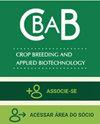Selection of maize hybrids: an approach with multi-trait, multi-environment, and ideotype-design
IF 1.1
4区 农林科学
Q2 Agricultural and Biological Sciences
引用次数: 2
Abstract
The present study aimed to evaluate the applicability and efficiency of the FAI-BLUP index in the genetic selection of maize hybrids, using 84 maize hybrids that were evaluated for cycle, morphology, and yield traits in four environments. Models accounting for homogeneous and heterogeneous residual variances were tested, and variance components were estimated using the residual maximum likelihood. Genotypic values were predicted by best linear unbiased prediction, and factor analysis was applied to group the traits. The FAI-BLUP index was used for the selection of maize hybrids based on ideotype design. Three factors explained more than 70% of genotypic variability, with selective accuracies varying from low (0.46) to high (0.99). Predicted genetic gains were positive for traits related to yield and negative for traits related to cycle and morphology, as is desirable in maize crop.玉米杂交种选择:多性状、多环境和理想型设计方法
通过对84个玉米杂交种在4种环境下的循环、形态和产量性状进行评价,评价FAI-BLUP指数在玉米杂交种遗传选择中的适用性和效率。对考虑同质和异质残差方差的模型进行检验,并使用残差最大似然估计方差成分。采用最佳线性无偏预测法预测基因型值,并采用因子分析对性状进行分组。采用FAI-BLUP指数进行理想型设计的玉米杂交种选择。三个因素解释了70%以上的基因型变异,选择准确度从低(0.46)到高(0.99)不等。与产量相关性状的预测遗传增益为正,而与周期和形态相关性状的预测遗传增益为负,这在玉米作物中是可取的。
本文章由计算机程序翻译,如有差异,请以英文原文为准。
求助全文
约1分钟内获得全文
求助全文
来源期刊
CiteScore
2.40
自引率
13.30%
发文量
25
审稿时长
6-12 weeks
期刊介绍:
The CBAB – CROP BREEDING AND APPLIED BIOTECHNOLOGY (ISSN 1984-7033) – is the official quarterly journal of the Brazilian Society of Plant Breeding, abbreviated CROP BREED APPL BIOTECHNOL.
It publishes original scientific articles, which contribute to the scientific and technological development of plant breeding and agriculture. Articles should be to do with basic and applied research on improvement of perennial and annual plants, within the fields of genetics, conservation of germplasm, biotechnology, genomics, cytogenetics, experimental statistics, seeds, food quality, biotic and abiotic stress, and correlated areas. The article must be unpublished. Simultaneous submitting to another periodical is ruled out. Authors are held solely responsible for the opinions and ideas expressed, which do not necessarily reflect the view of the Editorial board. However, the Editorial board reserves the right to suggest or ask for any modifications required. The journal adopts the Ithenticate software for identification of plagiarism. Complete or partial reproduction of articles is permitted, provided the source is cited. All content of the journal, except where identified, is licensed under a Creative Commons attribution-type BY. All articles are published free of charge. This is an open access journal.

 求助内容:
求助内容: 应助结果提醒方式:
应助结果提醒方式:


